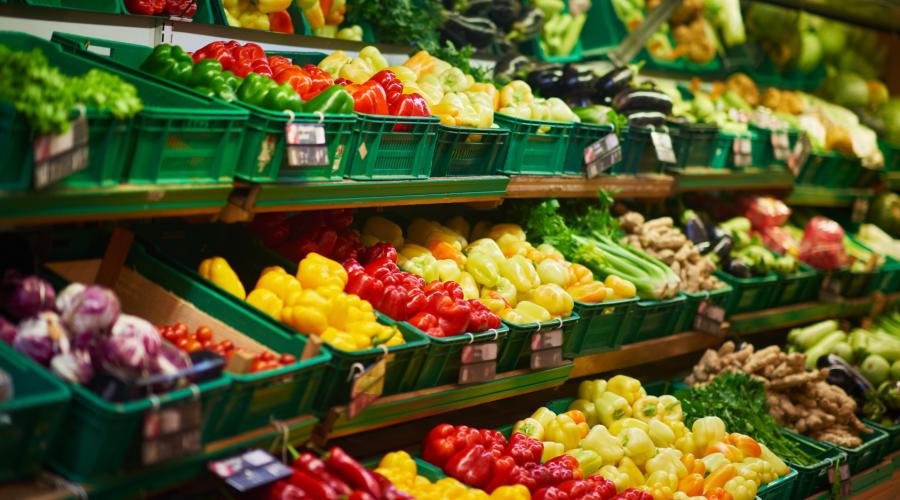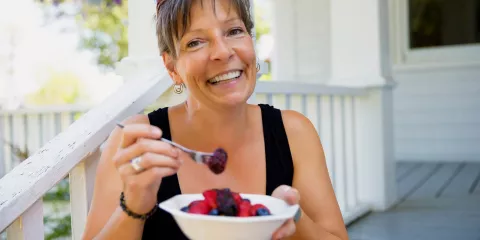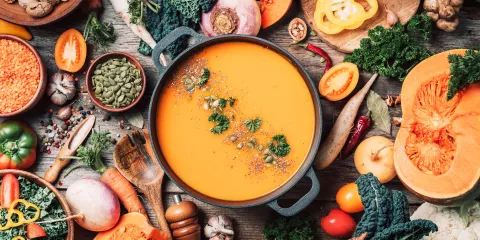
If you want to make simple steps toward making better food choices at the grocery store, it’s important to have a plan in place before you grab your cart and start shopping. By following these grocery shopping tips for healthy eating, you’ll find yourself leaving the grocery store equipped with healthy options for the whole family, much less junk food, and more money back in your pocket.
Download the Ubiquinol “Healthier Grocery List” now!
How to Make a Healthy Grocery Shopping Plan:
Make a List
Not just any list, a healthy grocery shopping list! Consider it your roadmap or GPS as you navigate through the grocery store aisles. You’ll need to decide the recipes you’ll be making ahead of time, and then write down everything you need for all of the recipes you’re planning to enjoy. Then, mark through the items you already have in your pantry. Be sure to include your healthy snack foods and any toiletries, pharmacy, or other miscellaneous items, and voila — you have your grocery list.
We’ve got some great healthy recipe ideas for you!
Organize Your List
Even with a list, a trip to the grocery store can feel daunting. Save yourself time and energy by grouping your list into categories or even by grocery store aisles. By organizing your list, you also reduce your chance of impulse buying and streamline your shopping trip. Instead of wandering aimlessly and choosing foods that comfort you, you’ll have an organized list that guides you through the aisles with ease. Trying to cut back on sweets and junk food? Don’t include that category and stick to your list!
The following categories are a great way to start:
- Produce
- Protein
- Condiments
- Grains
- Dairy or Non-dairy Products
- Healthy Snacks
- Beverages
- Baking Supplies
- Household Goods
- Body Care
- Pharmacy
Read the Labels
Do you know what’s in your food? When faced with so many options on the grocery shelf, it can be overwhelming to know which options are the healthiest. Knowing healthy food swaps can ease the decision making stress, and being able to understand and use nutrition fact labels will help you navigate the shelves with confidence. When reading labels, you may find sneaky preservatives, corn syrups, and other ingredients you’re trying to avoid. If there is no label, search for the product on your smartphone or download an app like MyFitnessPal for nutritional details.
Bonus tip: Filling your list with mostly fresh whole-foods like vegetables, fruits, nuts, grains, and proteins means less time reading labels and trying to understand ingredients.
Don’t Shop on an Empty Stomach
You might typically make healthy food choices, but if you’re hungry, everything and anything could end up in your cart. Plus, when you’re hungry (or even “hangry”), your patience may be thinner, potentially making your grocery shopping experience more stressful. To avoid impulse buying and headaches, fill up on a healthy meal or snack before heading to the grocery store.
Try Perimeter Shopping
Don’t have time to make a healthy grocery shopping list? Shop the perimeter of the store! With so many aisles full of processed and packaged foods filling the interior of the store, you can find solace in the produce, dairy, bakery, and meat sections that surround them.
Tips for Choosing Healthy Options by Category
Produce
- Think about “eating the rainbow” and fill your cart with a variety of color through your fruit and vegetable choices
- Stick with in-season fruits and veggies for the most nutrition and flavor
- Be sure to include a variety of dark leafy greens
- Buy your veggies pre-cut, ready to go into recipes if you’re short on time
- Bonus points: buy your produce at a farmers market for fresh in-season fruits and vegetables that directly support your local economy
Bakery
- Look for the words “whole wheat” or “whole wheat flour” on the label
- Choose whole grain breads with at least 3 grams of fiber per serving
- Shoot for less than 100 calories per slice or serving
- Avoid the sweets
Meat & Seafood
- Choose lean cuts of red meat. This means the lowest fat percentage or the least marbling
- Opt for ground chicken or turkey instead of beef in some recipes to lower the fat content
- Choose fresh fish high in omega-3 fatty acids. Salmon, Albacore Tuna, Mackerel, Rainbow Trout, Herring, Sardines, and Mahi-Mahi are your best options
Pasta & Rice
- Choose brown rice and whole wheat pasta
- See if you can replace your entree’s pasta with veggie options like zucchini “zoodles”, sweet potato noodles, or cauliflower rice
Sauces, Salad Dressings & Condiments
- Watch for sodium and sugar in sauces and condiments
- Opt for low-fat, low-sugar options, and low-fat/fat-free alternatives
- Consider making your own to avoid preservatives
Cereal & Breakfast Foods
- Just like in the bakery, look for whole-grain or multigrain products
- Go for the high-fiber, low-sugar options when choosing cereal bars and other breakfast foods
- Berries and dried fruit can be used to add sweetness to cereal if needed
Soups & Canned Goods
- Watch for salt and try low-sodium products where possible
- For canned fruits, look for the label that states “Canned in Real Juice” instead of syrups
Frozen Foods
- Frozen fruit is a great addition to healthy smoothies
- Look for frozen vegetables without added sugar or salt
- Be wary of preservative-filled frozen dinners and opt to cook from scratch if you can
Dairy, Cheese & Eggs
- Non-fat and low-fat are the key words to look for
- Buy plain yogurt and flavor it yourself with honey and fresh fruit to reduce the sugar and calories
- Switch from whole milk to 1%, 2% or skim milk or opt for unsweetened plant-based options to go dairy-free
Beverages
- Choose “100% juice” options rather than juice made from concentrate
- Add fresh or frozen fruit to sparkling water to satisfy a soda craving
- Make your own iced tea with real tea bags and sweeten it with honey or agave
Snacks, Crackers & Cookies
- Choose whole grain or multigrain where possible
- Whole food nuts and seeds like almonds, cashews, sunflower seeds and walnuts are filling and full of nutrients
- Choose dark chocolate over milk chocolate, which tends to have more sugar
Start Healthier Grocery Shopping Today
These simple tips may take some time to get used to, but if you think of it like you’re building a new healthy habit, you’ll be shopping like a pro in no time! No matter how you create and organize your healthy grocery shopping list, opt for as many whole foods as possible, commit to avoiding impulse shopping by sticking to your list, and be sure to try new healthy options often to keep your healthy food shopping fun and exciting.












